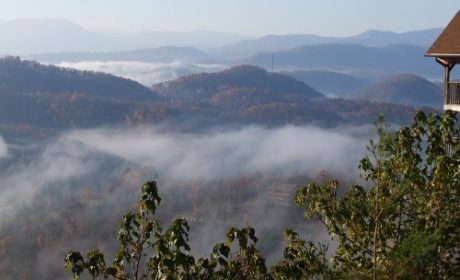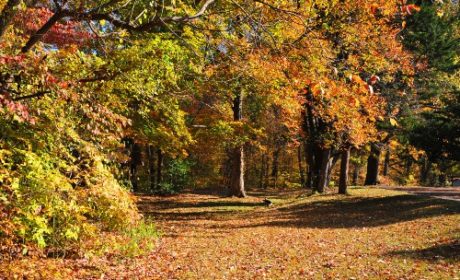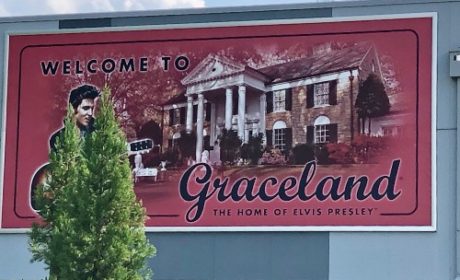If you’re looking for the best things to do in Nashville, Tennessee, Kathleen Walls (American Roads and Global Highways) shares her experience visiting Nashville and offers tips for making the most of your trip. Read about Civil War history, vibrant downtown Nashville, and a trip that will inspire a love for country music.
And once you checked out Kathleen’s 23 things to do in Nashville, take a day trip to Franklin! Or travel on a Southwest Virginia road trip to explore country music’s roots along the Crooked Road.
Nashville earned its nickname, “Music City,” with its abundance of music related attractions. Naturally, country music reigns here (it’s a prime destination on a Southern musical road trip), but there are other things in Nashville worth visiting.
Nashville is an old city compared to many U.S. cities, so you will find lots of historical attractions. There are also plenty of nature related places to visit.
Here are 23 things to do in Nashville that will keep you busy for several days, although a week is my preference.
Table of Contents
1. Music Row
The Old Town Trolley (purchase tickets here) takes you past Music Row. The driver points out the recording studios and record label offices on the route.
The two guitars out front make Columbia Studio easy to recognize. The guitars belonged to famous artists who recorded here and have Roy Orbison and Heartbreak Hotel on their necks.
Producer Owen Bradley built this first studio along Music Row. Johnny Cash and June Carter Cash, Bob Dylan, Lynn Anderson, and Patsy Cline are among the famous stars who recorded here.
Owen Bradley Park features Bradley sitting at a piano playing. He leaves room for you to sit next to him for a selfie.
Another artwork, Musica, a sculpture by Alan LeQuire, sits directly in the center of the Music Row traffic circle. The trolley driver said locals call it “Nudies.”
Another Nashville sight locals call by a different name is the tallest skyscraper in Tennessee, the 33-story AT&T Building, AKA “Batman Building.” One look at the silhouette of the building’s peak, which resembles Batman’s mask, tells why.
Tip: Be sure to remember the last trolley run time so you can get back to your car.
2. French Lick (Free)
French explorers used the area where Nashville is today as a trading post in the 1700s. They called it French Lick.
In 1779, during the American Revolution, a group calling themselves Overmountain Men built Fort Nashborough to defend what became the United States. Fort Nashborough History Center is a recreation of the original fort on the Cumberland River, very close to the actual spot it once stood.
Enjoy the free, self-guided tour. Cabins, both one and two story ones, are completely built of logs, even the chimneys.
A log stockade encircles the center. There is a small Native American plaza. Be careful around the fort as there are many homeless people begging and it could be dangerous for a single person.
3. Fort Negley (Free)
Fort Negley includes a large visitors’ center/museum with some exhibits and a video explaining how Union Troops built the fort to defend Nashville from attacks by the Confederates. The fort is about two miles out from town, so parking is no problem here.
A path winds around Fort Negley. Take your time to read the placards placed throughout the ruins that explain the fort’s significance.
An interesting tidbit, with no relation to the history, is that goats live behind a fence probably to keep the grass down. The view of Nashville is great.
4. The Hermitage
Whether you love him or hate him (read his biography), Andrew Jackson’s home, The Hermitage (official website), is worth a long visit. At over 1,000 acres, there is so much to see here.
Start your visit at the museum to watch the video about Jackson’s life. The newest exhibit at the museum, Born for a Storm, takes you from Jackson’s youth through his adult life.
There are exhibits about the Battle of New Orleans, a stepping-stone to his presidency. You’ll also learn about his marriage to Rachael before her divorce from an abusive first husband was final.
From the museum, walk over to the mansion where you’ll learn about Jackson’s life mostly after the presidency. A knowledgeable, costumed guide leads you through the home.
You’ll find a lot to see on the grounds. A restored cabin that was home to enslaved Alfred Jackson is interesting.
Alfred, who was born into slavery, lived in this modest 1840’s log cabin until his death in 1901. It’s furnished much as it was shortly before his death.
What was once the original Jackson family home, then a two-story log building, still stands. Jackson altered it drastically after moving to the Hermitage. He cut it down to one story to use as a slave cabin.
Take a minute to enjoy the garden. You’ll also want to stop at the Natchez Hills Winery on the grounds for a taste of Middle Tennessee wine.
5. Belmont Mansion
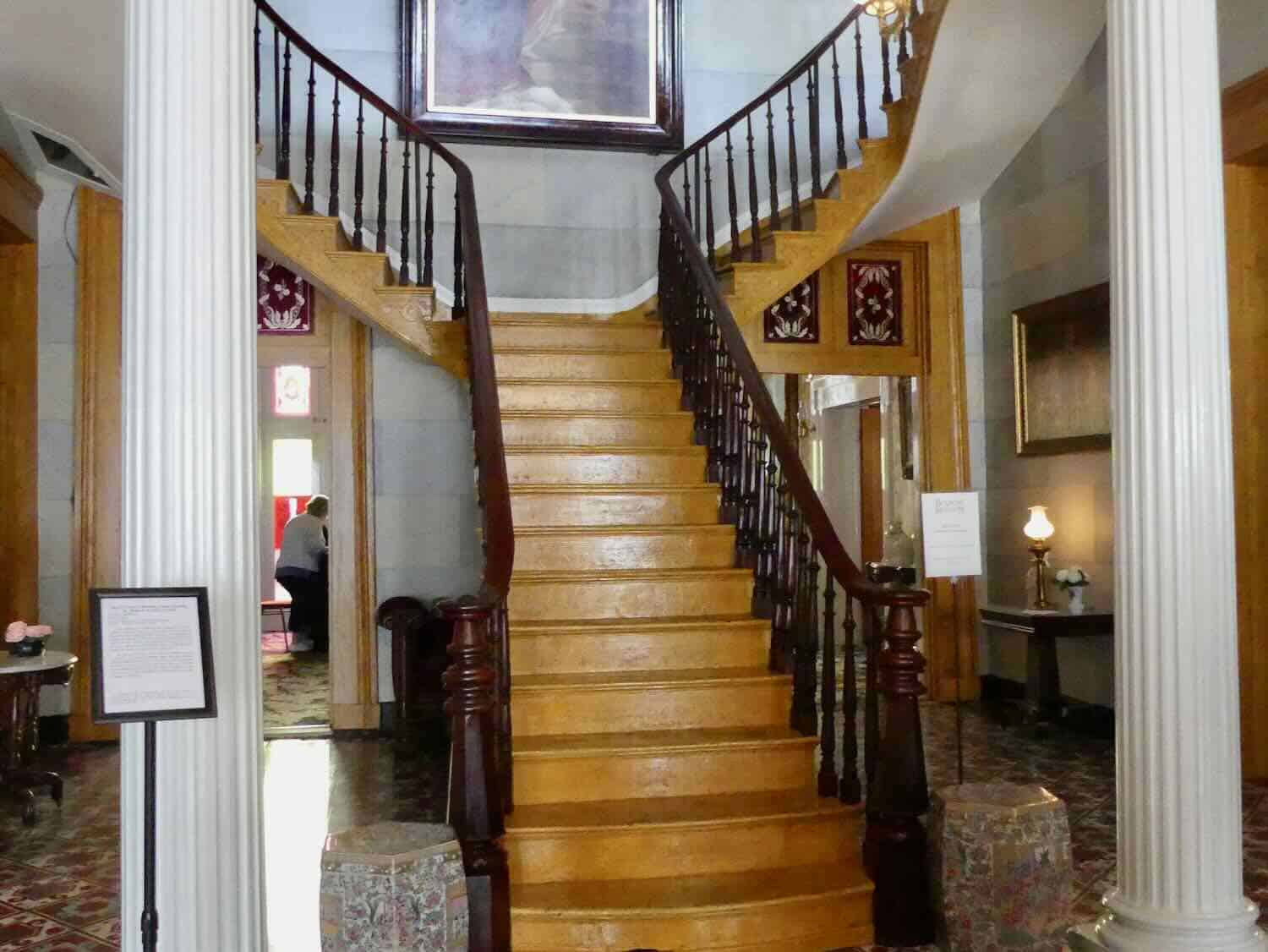
When you visit Belmont Mansion (purchase tickets here), reflect on the fact it dates to pre-Civil War, when women were just frivolous playthings who had no head for business. Then see your stereotypes toppled as you learn the history when docents show you the mansion.
At age 22, Adelicia Hayes Franklin Acklen Cheatham, married 50-year-old Isaac Franklin, co-owner of the largest slave trader company in the county. When he died seven years later, he left her a Tennessee plantation, several plantations in Louisiana, land in Texas, stocks, bonds, and 750 slaves, making her the richest woman in Tennessee.
In her two later marriages, she kept control of her assets. During the Civil War, she even smuggled a large cotton crop from her plantations past both Union and Confederate soldiers out to England, where she sold it for a good price.
Belmont reflects her immense wealth. Although she built it with her second husband, Joseph Alexander Smith Acklen, as a summer home, it rivals any millionaire’s home of the period.
The furnishings are heavy Victorian pieces with lots of gold trim. Art, both statues and paintings, abounds. The staircases are gorgeous. The house is 19,000 sq ft and has 36 rooms.
If you do the self-guided tour, there are placards and docents in most of the rooms to explain the how and when of each of the pieces. Today, Belmont Mansion is part of Belmont University.
6. Nashville Farmers Market (Free)
Nashville’s Farmers’ Market is a great place to grab a quick lunch. You’ll find every kind of ethnic food you can imagine, but also lots of regular home style meals.
However there is much more to the Nashville Farmers Market. After browsing the farmers’ stalls for locally grown produce, check out the large array of plants and garden products.
Handmade items range from art and jewelry to lotions and clothing. If you are visiting on the 3rd Friday from 5 p.m. to 9 p.m, the Night Market offers a musical event with one or more local musicians.
This is also about the closest free parking you will find to downtown. You can either walk or use the Old Town Hop on Hop off Trolley.
7. Tennessee State Museum (Free)
Tennessee State Museum (official website) traces Tennessee history from its first people to present day. Upon entering the museum, you’ll see a video beginning with the earliest people to the arrival of European settlers.
There are exhibits of an early settler’s cabin, a covered wagon that brought settlers to Tennessee. Learn about the Revolution in Tennessee.
Naturally, you’ll find Andrew Jackson well-represented here. You’ll learn about Sam Houston and Davy Crockett’s Tennessee congressional careers, including how Houston supported Jackson and Crockett opposed him, especially regarding The Indian Removal Act.
The Civil War is interpreted. The museum doesn’t shirk the evils of slavery and the founding of the Klan.
Naturally, the 19th Amendment giving women the right to vote is covered. Tennessee was the state casting the decisive vote that passed the amendment into law. The two world wars are covered well.
The museum also explores the state’s culture, especially music. You’ll find many musical exhibits that range from Elvis to Patsy Cline.
Exhibits of old stoves, iceboxes, and refrigerators represent everyday life. The museum is free and a must-see.
8. Tennessee Agricultural Museum (Free)
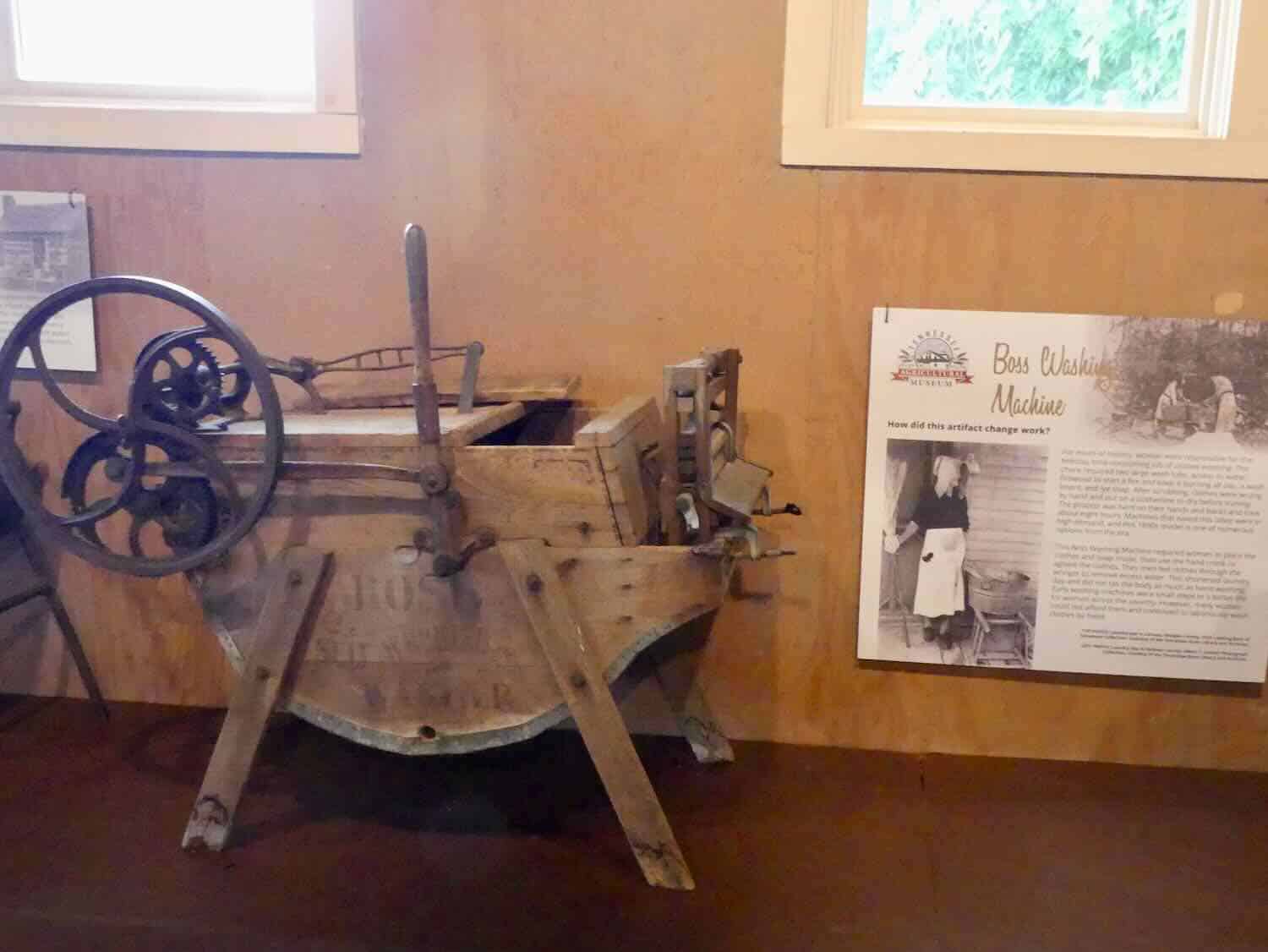
Agriculture is important in Tennessee. The Tennessee Agricultural Museum (free admission), housed in a large white barn, displays the machinery that plowed the earth, harvested the crops, and turned it into delicious meals. T
There are over 3,000 farm and home artifacts from early days housed between the barn floor and in its loft. One exhibit is a huge Post/Pole Driver. The machine is so tall it reaches from the floor up into the barn’s loft.
Another display, The Boss Washing Machine, shows how women’s washday became significantly easier. Instead of spending all day washing clothes in a tub and scrubbing them on a scrub board, she put the clothes and soap into the machine’s tub and turned the hand crank to agitate them. For wringing, clothes were fed into the hand-cranked wringer attached to the machine.
A well-preserved wood stove was another machine that made women’s work easier. It even had a temperature gauge on the front of the oven.
Although there are fascinating machines inside, the outside is equally interesting. A shed holds more farm instruments.
You’ll also enjoy walking through the garden. Explore several log cabins, including the old Safley School House, and a dogtrot cabin.
Boomer Travel Tip
Did you know the Natchez Trace Parkway begins (or ends) in Nashville? Check out our Natchez Trace Parkway road trip guide to plan your trip.
9. Centennial Park and the Pantheon
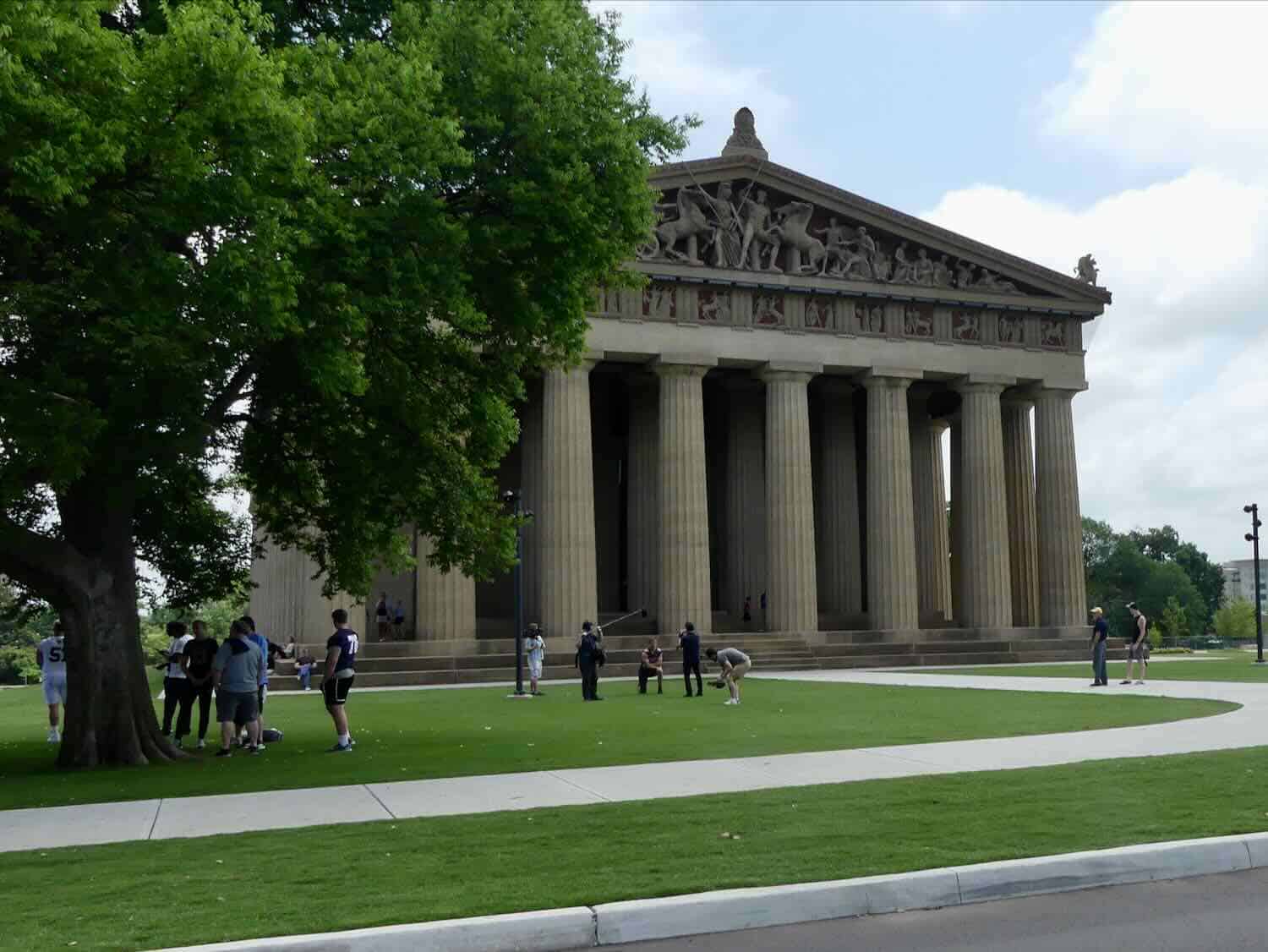
Nashville’s Parthenon is the world’s only full-sized replica of the original one in Greece. It’s at the center of Centennial Park, where you’ll also find another free parking area.
Built in 1897, The Nashville Parthenon celebrated Tennessee’s statehood centennial. It fit the theme of Nashville’s other nickname, “Athens of the South.”
The highlight of the museum is a 42-foot statue of Athena, also a replica of the one in Greece. Of course, there are many other art pieces besides Athena.
10. Nashville Zoo at Grassmere

Nashville Zoo at Grassmere (official website) has all the usual animals and then some. But some residents always catch your eye more than others.
On my visit, A red-ruffed lemur and his neighbor, a cotton-top tamarin, both sat on branches and looked out as if asking people to save the rainforest for their relatives. Both are critically endangered.
Big cats like cougars and tigers seemed to know they rule. The zoo’s “Unseen New World” exhibit is a fascinating look at mainly reptiles of Columbus’s New World, the Americas and the West Indies. There are rhinoceros iguanas, emerald tree boas, poison dart frogs, and much more.
What makes this zoo unusual is that part of the attractions you visit here include the Grassmere Historic Home, Davidson County’s second oldest residence that is open to the public. There are also outbuildings to help understand the Grassmere lifestyle.
There is a smokehouse that was so important before refrigeration. You’ll also visit a cabin for tenant farmer, Frank Morton, and his family that was once a slave cabin.
11. Ryman Auditorium: home of the Grand Ole Opry
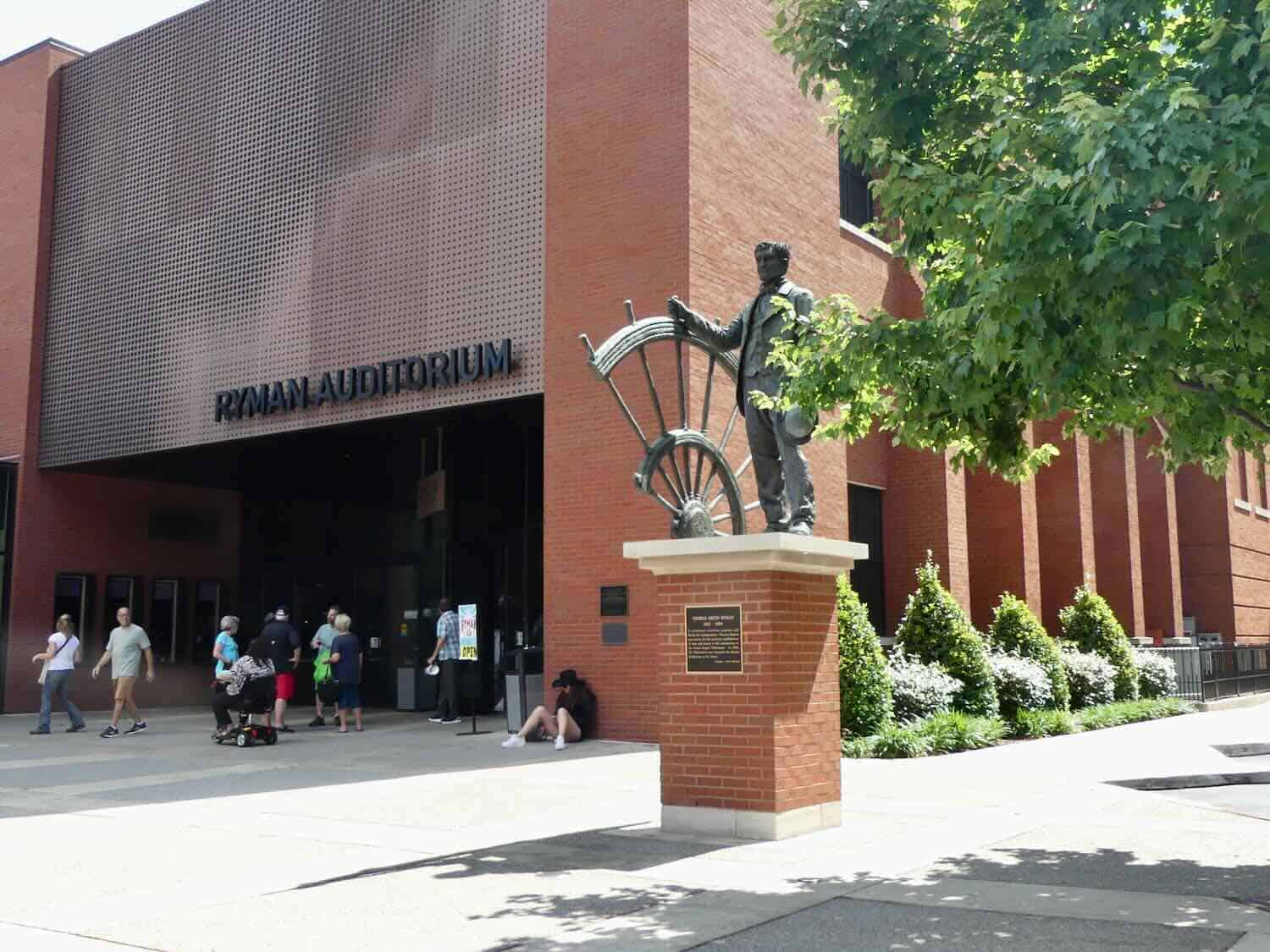
Ryman Auditorium (purchase tickets here) gained fame as the home of country music. Visitors may wonder why there is a stature of Captain Thomas Ryman at the wheel of a riverboat in front of the auditorium.
Ryman Auditorium started in 1892 as a very different entity.Th omas Ryman, a local saloon and riverboat fleet owner, attended a revival held by Preacher Samuel Porter Jones, intending to mock him. Instead, Ryman became a staunch convert and built the auditorium as the Union Gospel Tabernacle so large crowds could attend religious services.
In 1925, a show first called the WSM Barn Dance began. National Life & Accident Insurance Company hosted the show because they wanted to use what was then called “Hillbilly Music” to gain entrance to the homes of prospective customers.
WSM’s signal was so good folks could hear the show in 30 states. WSM Barn Dance later changed its name to the Grand Ole Opry.
On June 5, 1943, the Grand Ole Opry began shows at the Ryman. It showcased talents like Roy Acuff, Minnie Pearl, Bill Monroe and the Bluegrass Boys, and Mother Maybelle Carter and the Carter Sisters.
One of the Carter Sisters who performed as a child star married one of the biggest names in County Music. Yes, June Carter Cash performed at the Opry before Johnny Cash ever cut a record.
The Opry was an inspiration to many poor farmers’ sons and daughters for whom the Saturday night radio show was a lifeline to a different life than they knew. Many big stars of the ’50 and ’60s were inspirited by the Opry to seek a music career. Here’s how to purchase tickets to attend the Grand Ole Opry.
12. Country Music Hall of Fame
Country Music Hall of Fame Museum (purchase advanced tickets here) honors those who made big contributions to Country Music. It’s not just singers. Songwriter team Felice and Boudleaux Bryant, best known for their hit “Rocky Top,” the state song of Tennessee, has an exhibit.
Every Country singer you ever heard of is in the Country Music Hall of Fame from Minnie Pearl and Roy Acuff to Brooks and Dunn and The Judds. You’ll find every type of Country Music from early Hillbilly to Outlaw and Armadillo to Rock-A-Billy and Southern Rock.
The museum is huge and so are some artifacts. You’ll see Elvis’s gold plated Cadillac.
Webb Pierce’s ’62 Bonneville Convertible Nudie Mobile, designed by Nashville’s most flashy clothing designer-to-the-stars, Nudie Cohn, even beats Elvis for flashy. It has steer horns on the front bumper, a bucking bronco, and a colt revolver on the hood, six shooters for door handles, a gun on the trunk, and a saddle between the bucket seats.
13. RCA Studio B
Historic RCA Studio B is Music City’s only studio tour. You board a bus at the Country Music Hall of Fame Museum, which also owns Studio B. On the way, a guide shares Country Music history as you make the journey to Music Row to see for yourself.
The tours are limited in the number of guests and must get booked ahead to be sure of a spot. I enjoyed Brenda’s guiding. Ask for her if you have a choice.
Upon entering Studio B, there is a timeline showing who recorded what hits when and an entire plaque dedicated to Elvis. The studio is a typical studio; mikes, recording boards, instruments, and an isolation booth.
Studio B opened in 1957. It’s considered the home of “The Nashville Sound,” that type of Country Music that went from the raw honky-tonk sounds with a heavy fiddle and banjo, to more smooth string music with intricate background vocals.
What makes this place so special is the feeling of who recorded in this studio. Country and Rock fans will feel as if they’re standing on sacred ground.
Chet Atkins managed the studio and performed with many of the singers, including Elvis Presley. Elvis cut over 200 records here.
Some of the other big names that held these mikes and recorded here are Eddy Arnold, Waylon Jennings, Bobby Bare, Dolly Parton, Jim Reeves, Willie Nelson, Don Gibson, Mickey Gilley, Charley Pride, Floyd Cramer, and the Everly Brothers. And that’s just a start.
14. Walk of Fame (Free)
All the stars you saw in the Country Music Hall of Fame Museum and then some have a star in the park across the street. The Walk of Fame is fun to explore as you look for your favorite country music performers.
15. Musicians Hall of Fame
The singers get all the recognition, but the people who create the songs deserve credit. They get it at The Musicians Hall of Fame (purchase tickets here). All genres get representation here.
When you enter, the sign says “From Edison to Ipod.” There is a big exhibit with a piano showing the RCA dog sitting on it in front of the words, “God bless the boys who make the noise on 16th Avenue.”
From the early members of the Grand Old Opry to the UK singers who created the British Invasion, you’ll see them all here. The places that made music like Hitsville, USA AKA Motown in Detroit, Sun Studio and Stax in Memphis, Muscle Shoals Studio in Alabama, are well-represented. It is well worth the time and money.
16. Johnny Cash Museum
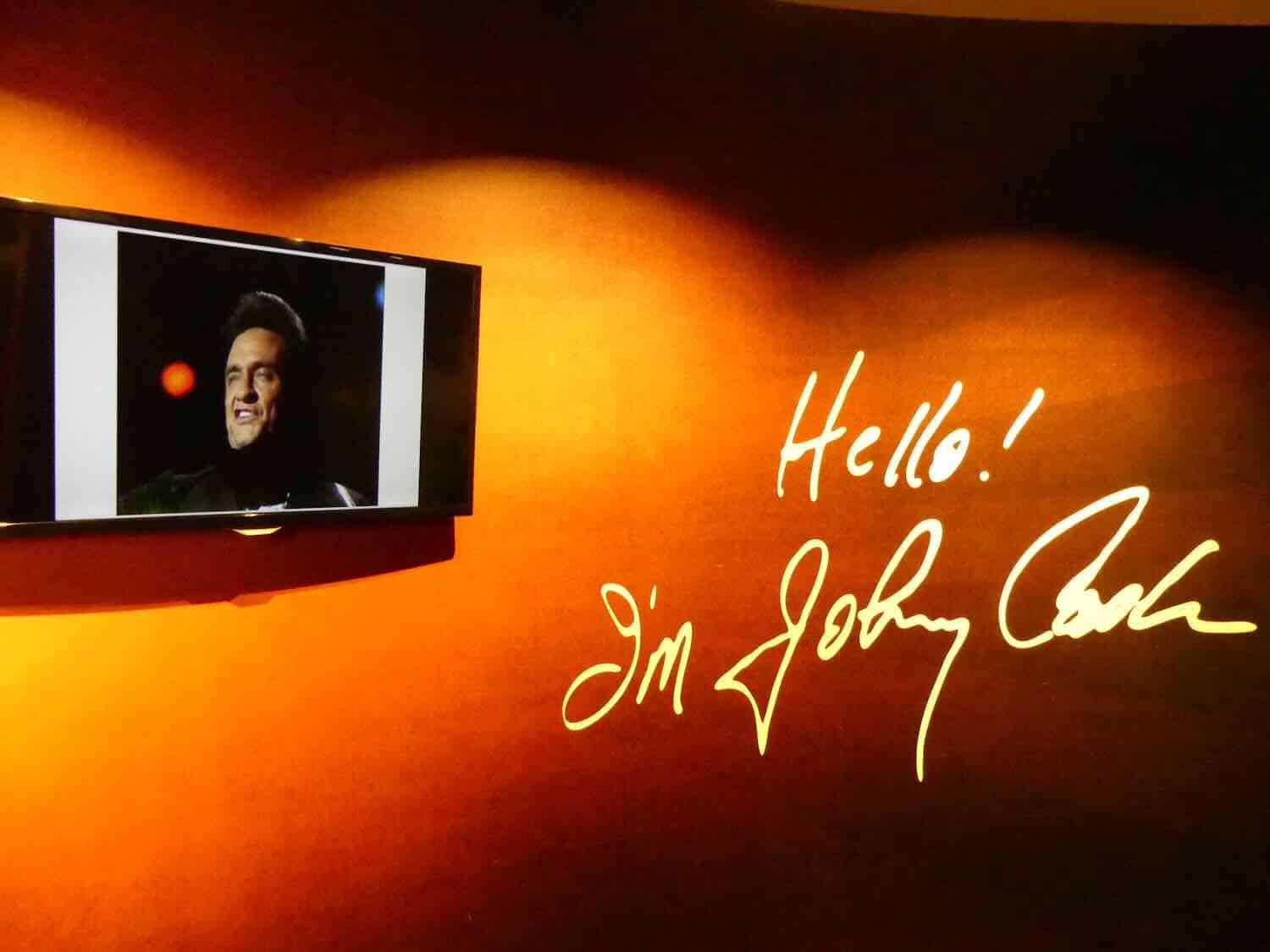
The Johnny Cash Museum (official website) is a fitting tribute to one of the greatest musicians of our time. It shows his childhood in Dyess, Arkansas and the flood that he witnessed as a child that inspired his song, “How High’s the Water.”
The museum shares the real reason he wore black at the beginning of his career. Spoiler; he and his band, The Tennessee Two, were too poor to buy costumes and the only clothes they had that matched were black pants and shirts.
Johnny Cash was never afraid to back down from his beliefs. When DJs refused to play “The Ballad of Ira Hayes” because it glorified a Native American, he took out a full-page ad in Billboard Magazine, daring them to play the song or admit they were cowards.
His music crossed many genres, Country, Pop, Rock-A-Billy, Outlaw, Rock-and-roll, Spirituals, and Americana. Cash doing the video of “Hurt” from his last album, just seven months before his death, is the final exhibit.
It is a perfect summing up of his life and his constant struggle with addiction. You will leave the museum with tears in your eyes.
17. Patsy Cline Museum
Patsy Cline Museum is upstairs above the Johnny Cash Museum. It tells the story of a brash courageous woman who made the journey from rags to riches and died way too young. She paved the way for women in Country Music as the first female performer inducted into the Country Music Hall of Fame.
The museum has a booth and other material from Gaunt’s Drug Store where Patsy worked as a teenager to help support the family after her father abandoned them. She grew up in Winchester, Virginia, and there are artifacts from her home and some dresses her mother, Hilda, who was a seamstress made for Patsy. Her dining room at the home she shared with second husband, Charlie Dick, is also recreated in the museum.
There are items recovered from her fatal plane crash just outside of Camden, Tennessee on March 5, 1963. Her manager, Randy Hughes, was piloting the plane with Cline and two other performers, Cowboy Copas and Hawkshaw Hawkins, aboard. He ran into rough weather, causing the plane to crash, killing all four of them.
Patsy’s fame increased after her death. Her most popular song, “Crazy,” reached number two on Country Music charts and is still covered by many other singers. It was also her biggest pop hit, reaching number nine on the Pop charts.
18. Willie Nelson and Friends Museum
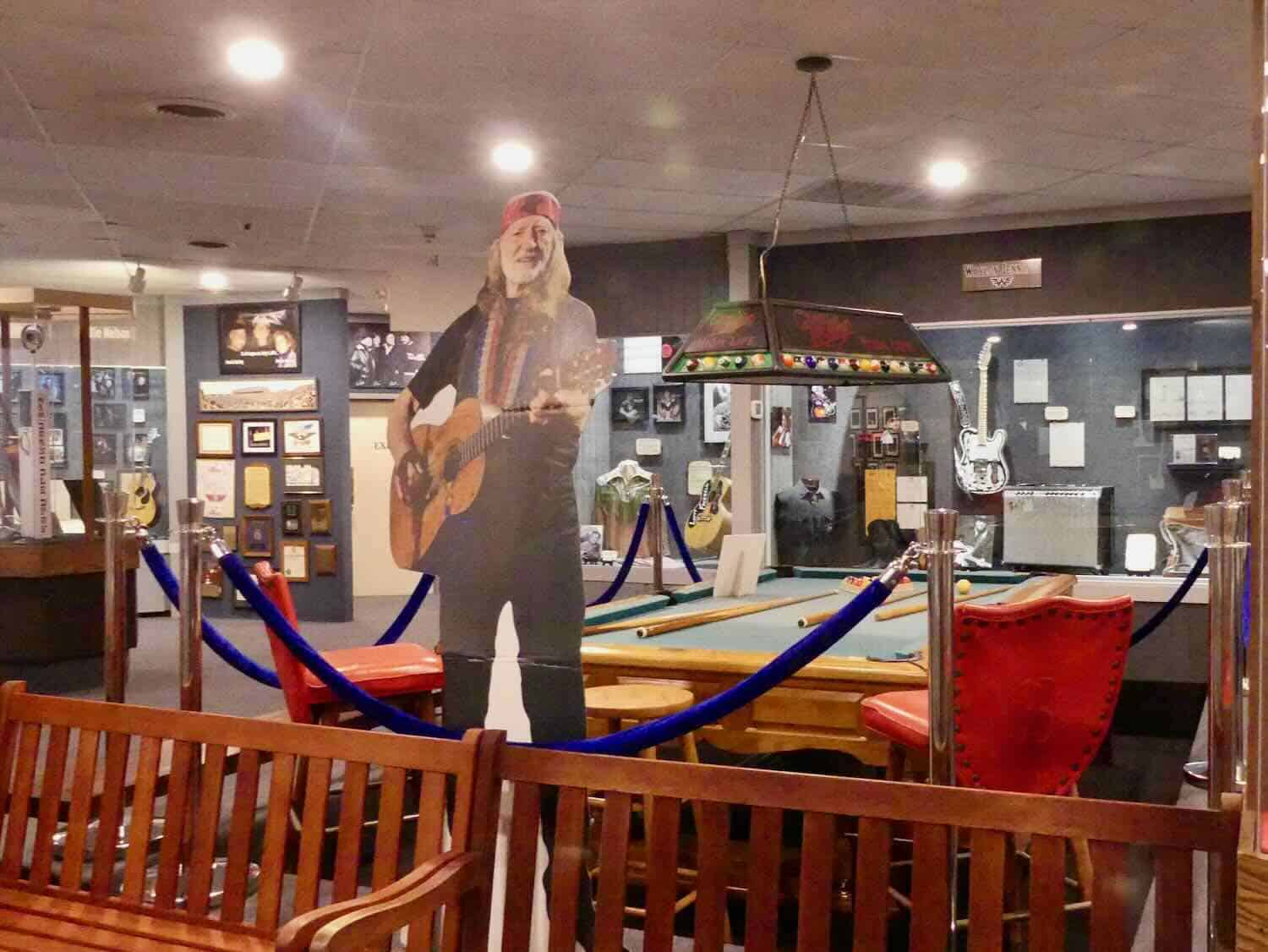
The Willie Nelson and Friends Museum (official website) began in 1979 when Willie opened it as the Willie Nelson and Family General Store. The museum tells not only about his life but lots about his friends.
Willie was born in Abbott, Texas. In Nashville, he was successful as a songwriter, but none of the record labels liked the way he sang.
Willie Nelson was the songwriter who wrote Patsy Cline’s “Crazy.” There’s a Patsy Cline exhibit here with some of her belongings.
Another hit he wrote was Faron Young’s “Hello Walls.” Naturally, there is a Faron Young exhibit too.
Since Willie sang with almost every singer of every genre, from Ray Charles to Julio Iglesias, there are many other stars represented there. You’ll see lots of Willie’s personal possessions, like his handmade domino table, his own billiard table, and more.
As a singer and actor, Willie didn’t strike it big until he left Nashville and moved back to Texas. His first album to hit the charts was “Red Headed Stranger,” recorded on the Columbia Label in 1975.
This album had his first song to hit number one on the country charts, “Blue Eyes Crying in the Rain.” It ranked on the pop charts as well and got Willie a Grammy Award for Best Country Vocal Performance.
Willie created a new genre, Outlaw Music, with Waylon Jennings. At 88, he’s still on the road performing.
19. Cooter’s Place
Right next-door is Cooter’s Place. While not as extensive as Willie’s museum, it is a must-see for all Dukes of Hazzard fans.
Ben Jones, who played Hazzard mechanic Cooter Davenport, a sidekick to Bo and Luke Duke, has assembled an extensive collection of show paraphernalia including General Lee, a 1969 Dodge Charger. Sheriff Rosco P. Coltrane’s Plymouth Fury police car is another selfie spot. You’ll find Cooter’s tow truck parked out front.
20. Glen Campbell Museum
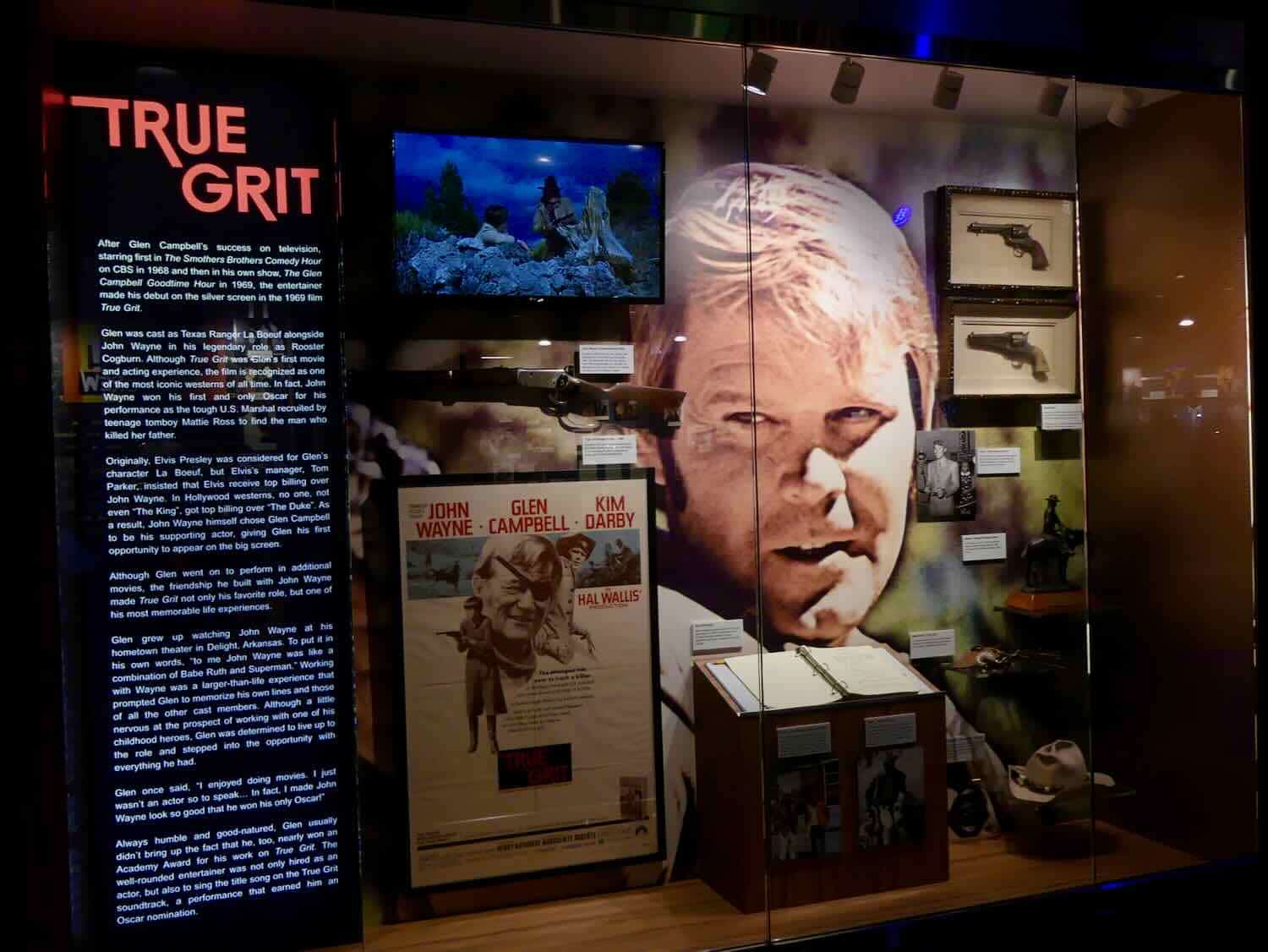
Glen Campbell Museum (buy tickets here) portrays the life of a remarkable man. Glen Campbell’s talent didn’t recognize boundaries.
He played and sang Country, Pop, Rock, and, later in his life, Spirituals. Glen appeared on many television shows, was the voice of Chanticleer, the rooster in Don Bluth’s film Rock-a-Doodle, and hosted his own TV show, The Glen Campbell Goodtime Hour.
He played in movies and earned a Golden Globe nomination for Most Promising Newcomer for his supporting role in True Grit. In 2012, Campbell won the Grammy Lifetime Achievement Award. He also was honored with an ACM Honors Career Achievement Award on August 30, 2016.
He faced death bravely, publicly announcing his diagnosis of Alzheimers. He then performed a farewell tour.
The museum showcases Glen Campbell’s life and achievements. Many of his personal items and records are on display for you to see.
There are interactive exhibits like “Mix A Song!” where you can do the mixing of some of his songs. If you are looking for live entertainment, their Rhinestone Stage presents music concerts.
21. George Jones Museum
George Jones Museum (skip the line ticket) tells the life of one of Country Music’s most controversial singers. For a singer to earn the title of “No Show Jones” and still be one of the most popular musicians, takes some talent plus a lot of booze.
George Jones gained a reputation as much for his alcoholism as his music. The infamous lawnmower he drove to the bar when his then wife, there is some debate about whether it was Shirley Corley or Tammy Wynette, locked up his car, and hid the key, is on display.
George Jones was one of those kids who was inspired by listening to the Grand Old Opry on the radio in his home near Beaumont, Texas. He vowed to follow in the footsteps of his idol, Hank Williams.
He did just that, amassing more top hits than any other country artist. His first number one hit, “White Lightnin’,” hit at the top spot in 1959.
During his marriage to Tammy Wynette, his third wife and a big name in Country Music in her own right, the duo recorded some famous duets. “We’re Gonna Hold On” and “Golden Ring” earning them the title “Mr. and Mrs. Country Music.”
The marriage lasted six years, but they sometimes recorded and performed together afterwards. His fourth wife, Nancy Sepulvado, was the influence that helped curb his alcoholism and drug addiction.
Besides having an impressive amount of Jones’s possessions and albums, the museum is interactive with one spot where you can record yourself singing along with him.
22. Belle Meade Plantation
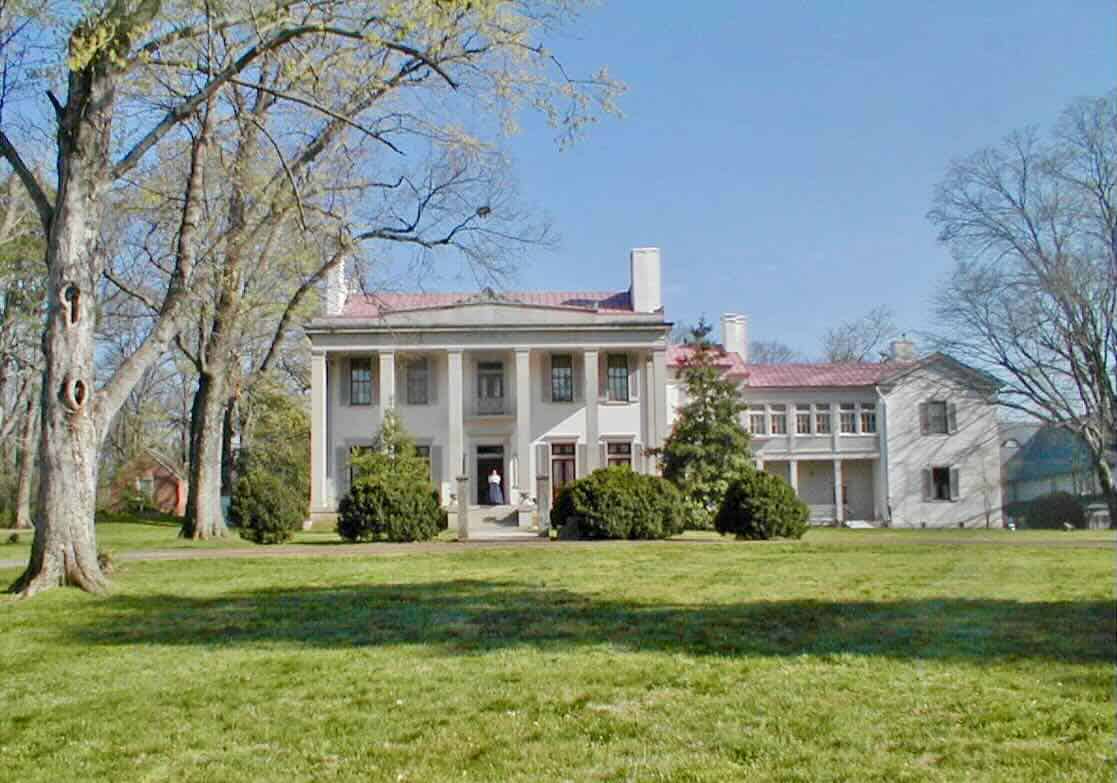
Belle Meade Mansion and Winery (purchase tickets in advance) has changed a lot over the past 200-plus years. It began as a modest log cabin on a 250-acre tract when John Harding bought it in 1807. He named the property Belle Meade, meaning Beautiful Meadow, and began a stud farm and racing tradition that was unequaled.
Today, it’s more than a magnificent antebellum home you can tour to experience upper-crust lifestyle of the old south. The racehorse tradition is no longer but the old structures, original log cabin, carriage house, stable, and slave cabins are still there.
There are several tours. The most popular are the original Mansion Tour, Journey to Jubilee, which highlights the lives of the enslaved people before and after emancipation, or a Segway tour of the garden and grounds.
On the mansion tour, a period costumed docent takes you through the Greek revival home. You’ll hears its history as you wander through rooms furnished as they were in the heyday of the plantation.
Before we entered, our docent pointed out the bullet holes in the front of the home. William Giles Harding, who had inherited Belle Meade from his father by the time of the Civil War, was an ardent Confederate.
He owned 136 enslaved people and was the wealthiest landowners in the area. It’s not surprising that there were skirmishes around his home.
Over the years, many famous people visited Belle Meade including three presidents, William Howard Taft, Grover Cleveland, and Theodore Roosevelt.
One of my favorite stories our docent told was about Taft. He weighed over 300 pounds and one day got stuck in the bathtub and had to be pulled out by the servants. By his next visit, the Hardings –incidentally no relation to that president—had installed a large new shower on the second floor for heavier guests.
You end the tour with a complimentary glass of their wine at the onsite winery. Be sure to enjoy a meal at Harding House, which serves lunch daily and a weekend brunch.
23. Cheekwood Gardens & Mansions

Cheekwood Gardens & Mansion (official website) is a beautiful testament to how people who own businesses like Maxwell House Coffee can afford to live. It all began in 1896 when Leslie Cheek married Mabel Wood.
Leslie worked in his families’ business, Cheek-Neal Coffee Company. The story is they built the mansion because Mabel had a tall gilt mirror that wouldn’t fit in their original home.
The mansion is filled with art and furnished elaborately, but for me the main attraction is the gardens. A multitude of different style gardens range from a precise Boxwood Gardens to a Children’s Garden with a running model train and other interactive features to hold a child’s interest and fascinate adults as well.
Visit the Robinson Family Water Garden with its ferns, hostas, and so much more running wild along a rocky mountain-type stream. There is a Sculpture Trail, a Japanese Garden, an Herb Study Garden, and many more.
My favorites are the Rose Garden and the Dogwood Garden. The profusion and varieties of the roses are amazing.
How to get to Nashville
Nashville is easy to get to by car or air. Three interstates connect the city to the rest of the country. I-40, I-24, and I-65 all come into Nashville. Nashville has a local airport for those flying, Nashville International Airport (check flights here.)
Although easy to reach, driving or parking in the downtown area is difficult. You will find heavy traffic, many roadways are being repaired and blocked, and not enough metered parking places.
There are public lots but they are expensive. Your best bet is to use public transportation.
Getting Around on the Old Town Trolley
The Old Town Trolley (buy tickets here) offers a hop on hop off service that stops at places visitors frequent. It’s a bargain compared to parking in lots.
The drivers are personable and give you an informational tour as you ride. There are 14 stops. They start downtown at Broadway and Second Street near the George Jones Museum. The furthest out is stop is number 11 at Centennial Park, where the Parthenon is located.
Stay at Gaylord Opryland Resort
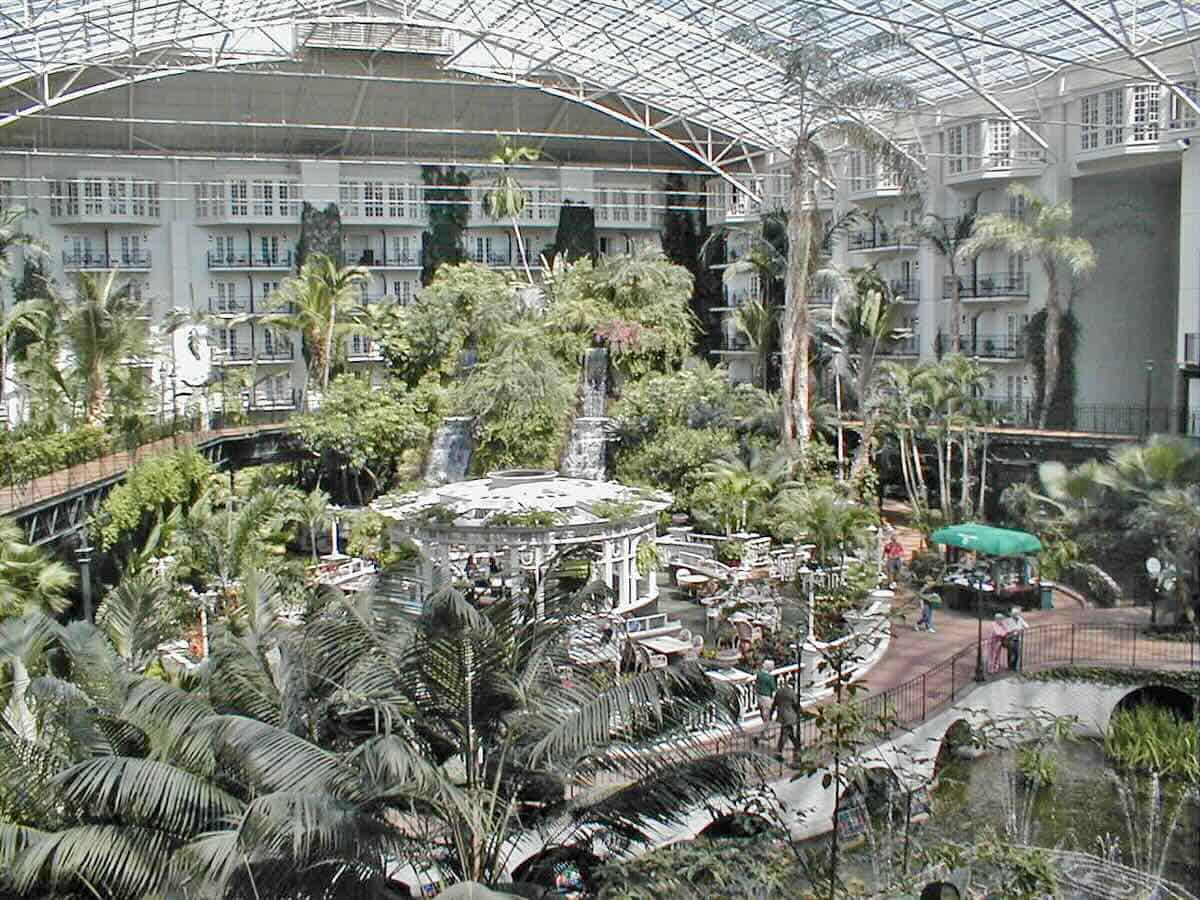
Gaylord Opryland Resort (book rooms here) is a destination in itself. Besides the normal room and suites, which are far above your average hotel rooms, there are enough attractions dining and shopping to keep you entertained on the resort for days.
- There are gardens where you can dine listening to the sound of cascading waterfalls under their glass atrium.
- Take a cruise on a Delta riverboat down an indoor river.
- Shop in some of the stores in a New Orleans French Quarter style shopping area.
- Enjoy the play of lights and dancing water set to music with the Delta Fountain.
- Their newest attraction, SoundWaves, is not your kids’ waterpark. It’s designed for all ages.
Dine at NashHouse Southern Spoon & Saloon
There are lots of dining choices in Nashville. NashHouse Southern Spoon & Saloon is one of the best. The restaurant is a short walk from the Country Music Hall of Fame, or the Johnny Cash/Patsy Cline Museums.
The food is pure Southern, choices like fried green tomatoes or home style meatloaf with smashed potatoes. Do save room for the chocolate cake with ice cream for dessert.
NashHouse Southern Spoon ovvers down-home cooking with a fancy twist. The décor is pure Music City. They decorated the columns inside with larger-than-life images of Johnny Cash, Patsy Cline, and Dolly Parton.
There is outside seating as well. At night, you will enjoy live entertainment.
Tips to plan your visit to Nashville
Many people know how much fun Nashville is, so expect some crowds on the streets and sidewalks. Since there is so much to see and do, allow at least a week for your trip to Nashville, if possible.
Planning ahead is key to a fun Nashville visit
- Decide which attractions you will visit on which days and group them in convenient areas so you can walk between them.
- Check in advance to see which attractions have parking and which do not.
- Make reservations for attractions requiring timed tickets. You can do that here.
- Allow adequate time between the attractions that you are visiting.
Part of this trip was subsidized, however opinions are all my own.

